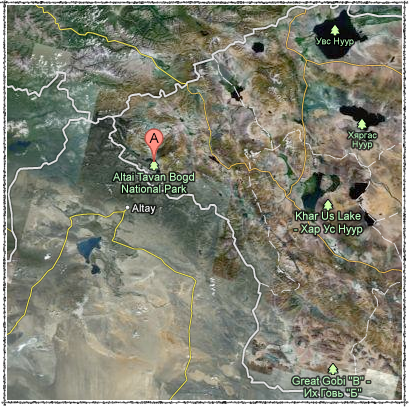


Altai Tavan Bogd Mongolia







In July 2009 I embarked on a trek through the Altai Tavan Bogd National Park in the far west of Mongolia. This remote and inaccessible region is high in the Altai Mountains near the point where the borders of Mongolia, Russia and China meet, and just 60 kilometres away from Kazakhstan.
The short description below outlines my travels to Altai Tavan Bogd from the nearest regional centre of Ulgii, my trek to the Potanina Glacier, and the return trip to Ulgii.
A gallery of 150 images of the trek can be seen HERE.

I have just had one of those momentous experiences of a lifetime, trekking in the mountains of Mongolia’s far west at the point where the borders of Mongolia, China and Russia all meet. My destination was the Altai Tavan Bogd National Park, about 2000 kilometres west of Mongolia’s capital city, Ulaan Baatar, and 200 kilometres west of the regional centre of Ulgii. The area is extremely inaccessible, and in order to get there I had to endure a time consuming process of getting a ‘border access permission’ pass, which nonetheless required a long explanation of why I wanted to visit the area at the roadside check point. Fortunately, you can justify going almost anywhere when you say you are a Geographer!
Altai Tavan Bogd can only be reached by 4WD vehicle. In my case, the 4WD was a UAZ-425 (pronounced “Wuzz”), a relic of 1960s Soviet engineering which could go absolutely anywhere provided its engine was not overheating - which was most of the time. Because of its shape, it is colloquially known as the “bukhanka”, which means “loaf”. I was sitting in the front seat beside the driver, and when driving through deep ditches and fording rivers, I really felt the landscape was coming up to hit me in the face, which it almost was as I was seated so close to the front of the vehicle. What the UAZ lacked in crash protection (no seat belts and a solid metal dashboard) and security (the seat was not fixed very firmly to the floor), it more than made up for in its ability to go anywhere - I was amazed how versatile the UAZ was in being able to handle impossible terrain.
My journey began in Ulgii, a town in Mongolia’s far west, from which the drive to the entrance of Altai Tavan Bogd National Park was just over 200 kilometres through a variety of landscapes - grasslands, desert, alpine valleys. Mongolians are in the minority in this part of the country, and 90% of the population are ethnic Kazakhs, almost all of whom are nomadic graziers who live in yurts (or ‘gets’ in Mongolian). The welcoming hospitality was the Kazakhs was extraordinary, with many families inviting me into their brightly decorated yurts to share a meal of fermented yogurt blocks made from horse milk or yak milk, various unidentifiable types of cheese, and their distinctive tea - black tea with horse milk and salt added.
The final trek to the base camp in Altai Tavan Bogd involved an 18 kilometre walk - everyone else I saw chose to ride horses for this trek, but I chose to walk each way because I felt I would get a better feel for the landscape in this way, as well as getting some great exercise in sweet, fresh air, and being able to take more photos that way. And I did get lots of photos on this stunning walk - a link to the gallery of images can be found at the end of this page. The aching muscles after the 18 kilometre trek, during which I climbed 500 metres up to 3500 metres, were testimony for the exercise I did.
But it was worth it. The scenery was stunning and the environment sensational.
One of the great things about travelling to remote places that are off the roads normally travelled, is that anyone you met there is likely to be a Really Interesting Person. This was certainly the case on several occasions on this trek. At the base camp, for example, I became friends with a team of three researchers who were stationed there to measure the retreat of the Potanina Glacier. Employees of the Meteorology Office in Ulgii, they have been doing this work for five years with Japanese funding. Researchers stay at the base camp from the beginning of June to the end of September each year in 3 week shifts, and take daily measurements. Alarmingly, they have found that the Potanina Glacier is retreating by about 5 metres per year, exclusively due to warming temperatures (as opposed to changing rainfall patterns) in their opinion.
The researchers invited me to sleep in the floor of their (comparatively) warm yurt for the night I was there, an offer which I readily accepted as the rain and thunder outside turned into a snow fall. The next morning, in the clear bright mountain sunlight, they took me for a walk on the surface of the glacier to see some of their work.
Another interesting person I met, this time at Ulgii Airport as I was returning to Ulaan Baatar, was a young Australian by the name of Tim Cope. Tim is quite an adventurer (see his website), and I remembered reading his book “Off the Rails” about cycling across Russia several years ago. He has recently ridden a horse (actually several horses) overland from Mongolia to Hungary (as described in an “Australian Geographic” article in Jan-Mar 2008), and is currently doing quite a bit of anthropological research into the migration of Central Asian peoples, especially various Kazakh groups.
Altai Tavan Bogd is an extremely difficult place to get to, but the effort and the experiences were certainly worth it. Please have a look at the gallery of images (in two parts) HERE.
a short travel diary






